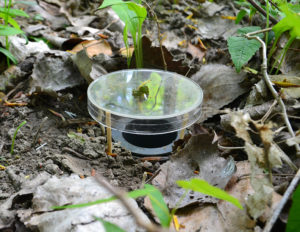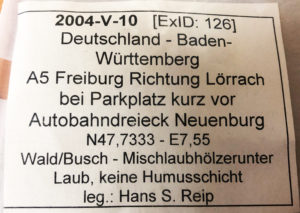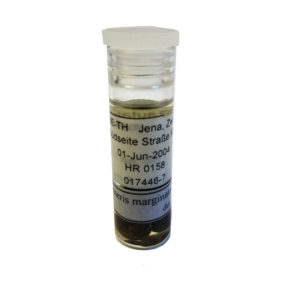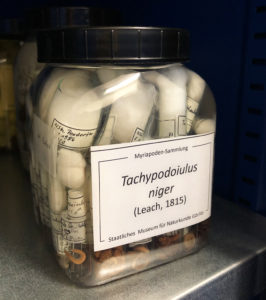Record
Best time to explore and record
Many soil animals can be found all year round in suitable biotopes, but during frost, great heat and drought, many soil animals retreat into deeper soil layers. The best time to explore and observe soil animals is therefore in spring and autumn with mild temperatures between 5 and 20 °C and moist subsoil. But even in the peak of summer, some species can still be found in damp places, e.g. in the garden, near water bodies or in compost heaps. Even in winter, some species are still active on the snow, such as some springtails, or under the snow in the leaf litter.
Collection methods
There are different methods to collect or record soil animals. The simplest method is hand collection, i.e. manual searching. The most important tool here is a forceps (spring steel tweezers) and for small animals like mites or springtails a brush or an exhauster. In manual collection, one searches for the typical habitats of ground animals. For example, one turns over stones, a piece of wood, board, a rotten branch or tree trunk. Some animals then sit there on the ground, wood or stone. Under the bark of rotten wood as well as on living trees (e.g. pine, plane tree, maple) dead wood inhabitants can be found by removing the bark with a knife in places. However, most species are found in the leaf litter and the first few centimetres in the ground. The litter and soil should be moist, but not dry and not completely wet. You can search the leaf litter or the earth directly or you can put the material on a white tarpaulin or large bag so that the sometimes very nimble animals cannot bury themselves or flee in any other way. You can also take substrate in a bucket or bag home and look through or read it in a shallow tub under a lamp. It is best to return the substrate to its original location afterwards and never dispose of it in the garden or any other place, as the native fauna could be distorted by other species.
Many species can only be reliably determined in a dead state and must therefore be killed. For this purpose the animal is killed directly in 70-95% alcohol (isopropanol, ethanol).
One of the most commonly used methods for catching ground animals that are active on the ground surface and in the litter is the use of ground traps or also called barber traps (after their inventor). In this method, cup-like vessels (e.g. yoghurt pots) are filled with a killing or preserving liquid (e.g. propanediol, saturated saline solution), buried at ground level, provided with a small roof to protect them from rain (= dilution/overflow) and changed every 2 to 4 weeks. This simple and inexpensive method of catching ground animals without a great deal of time and effort has given ground zoology a huge boost. A major disadvantage of floor traps, however, is that hundreds of different animals are killed without distinction when they fall into the cups, including some vertebrates such as mice and amphibians. This “by-catch” is unfortunately very often not processed further and therefore thrown away. It is therefore always necessary to consider beforehand what goals one is aiming for with the trap catch and whether its use is really justified.
Logging of findings
You can take the living animals home with you to identify or photograph them. A container filled with a few small ventilation holes in the lid and some moist litter is quite sufficient here. In order not to have to kill animals unnecessarily, you can take only 1-2 specimens of a species with some experience and if necessary with the use of a magnifying glass already in the field or release surplus specimens and young animals or females that cannot be determined.
For each collection or sampling one should make small protocols in a notebook. They help to record all the important information about the circumstances of the find and later also to attach a label to the conserved animals.
The following information should always be included:
– Collector (Who?)
– Date (When?)
– Place (Where?), i.e. e.g. country, state, nearest town, name of area (NSG, mountain), coordinates (WGS84, decimal degree), biotope (e.g. deciduous forest, garden) and, if applicable, information on vegetation (beech, maple, nettle field) or subsoil (decayed humus, stony, basalt, lime. Maps (paper form, smartphone) or a GPS device are helpful for determining the location.
– Collection method (How?), such as hand trap (HF), ground trap (BF) or other methods.
Conservation & Collection
The preservation of soil animals is usually done in 70% ethanol or isopropanol, which can be bought for about 5 to 10 € per liter in the pharmacy or on the Internet. The animals are put together with a label in small glass or plastic tubes (e.g., lamellar stopper glasses) and almost completely sealed. The label must contain at least the following information: species, country, area or nearby larger town, place of discovery, date, collector, collection number, if applicable number of a permanent preparation). For each species, larger jars bearing the species name are used in which these preparation tubes are placed. In order to prevent the tubes from drying out, the vessels are filled to the brim with alcohol. They should be checked regularly and alcohol should be refilled in case of evaporation (in case of very strong evaporation losses some 90% alcohol should be added).
Even though soil animals have not yet been included in most national protection lawys , nor in the appendices of the Habitats Directive or the EC Species Protection Ordinance, anyone who kills animals or wants to establish a natural history collection should be clear about the sense and purpose. However, please check you national laws about collecting the desired species. The material should either be left to a natural science collection or a separate private collection should be set up. Only by means of collections can the distribution of species, the ecological preferences of a species or the decline of species be recognized and documented. It is also possible to verify and document questionable finds or new species views of older specific material.
A separate collection should therefore always contain all important information on the species (name, number, sex) and circumstances of discovery (see Logging finds). The individual tubes should also contain labels that are self-explanatory for third parties. Every collector should determine the later whereabouts of the collection (e.g. specialized museum) to ensure the preservation of the collection and the professional use of his work. Important collections of terrestrial animals can be found in the following German museums and cities: Senckenberg Museum für Naturkunde Görlitz, Museum für Naturkunde Berlin, Zoologische Staatssammlung München, Senckenberg Museum Frankfurt, Zoologisches Museum der Universität Hamburg, Staatliches Museum für Naturkunde Karlsruhe.





